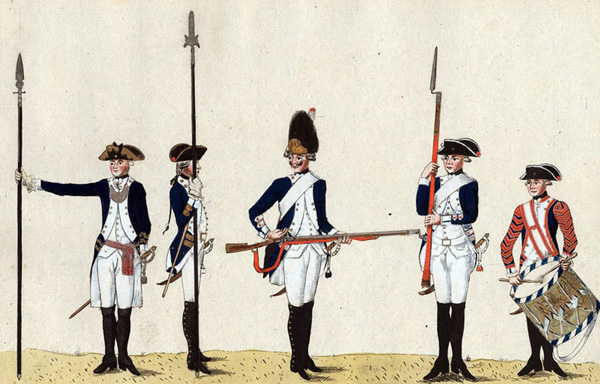Hessians in the American Revolution
The British Army recruited approximately 30,000 German troops as auxiliaries during the American Revolution. They were generically referred to as Hessians even though only about 65% were from Hesse-Kassel or Hesse-Hanau. They were not integrated into the British troops, serving in their own regiments under their own officers and wearing their own uniforms. They ended up fighting in almost every major battle of the war.

Hesse-Kassel had become one of the most militarized states in the Holy Roman Empire, even more so than Prussia. The state, itself, was rarely a belligerent. Instead, it's troops served as mercenaries for whoever would pay, sometimes even sending troops to both sides of a conflict. Note that the term "mercenaries" is disputed since there appears to be a fine distinction between mercenaries (individuals who rent themselves out to a foreign power) and auxiliaries (individuals who serve their own monarch, who rents them out). It's worth noting that many of these troops weren't serving for monetary gain; many were impressed, some of them debtors or petty criminals, and their pay went to the German royalty.
The use of the German troops by King George III is not surprising given that he was a member of the House of Hanover and the rulers of Hesse-Kassel and Hesse-Hanau were his brother-in-law and nephew, respectively. The German troops were disciplined and competent. It's interesting that contemporary accounts indicate that the Hessians disapproved of their British allies, thinking of them as unprofessionial in their wanton destruction of property and execution of prisoners. In America, the use of these troops was a major propaganda boon. Pamphleteers were able to portray King George III as a tyrant who hired foreign "butchers" to slaughter his own subjects.
The most famous example of conflict between Hessians and the Continental Army is the Battle of Trenton, commemorated in two famous paintings: Leutze's Washington Cross the Delaware and Trumbull's The Capture of the Hessians at Trenton December 26 1776. Crossing the river on the night of 26 December 1776, Washington surprised the Hessian forces, killing about 20, wounding about 100, and capturing about 1,000.

The Continental Army actively tried to induce Hessians to desert and join the American side. They offered 50 acres of land, two pigs and a cow to any individual who would do so. As for Hessian prisoners, they were generally held in the area of Lancaster, Pennsylvania, which had a large German population. The prisoners were treated well and appreciated that. Some volunteered to help with local work, allowing the Americans to join the Continental Army. After the war, many of the prisoners elected to remain in America, some researchers indicating the number may have been as high as 8,000 men.
Ironically, historians see the Hessian participation in the American Revolution as the downfall of Hesse as a mercenary state. The contractual obligation to maintain at least 19,000 troops meant that, eventually the Landgraves were conscripting farmers and tradesmen needed at home to replace the heavy losses. The supply lines were much longer...and, therefore, more expensive...than they were used to in European wars. Couple all that with the fact that they were defeated and it spelled the end.